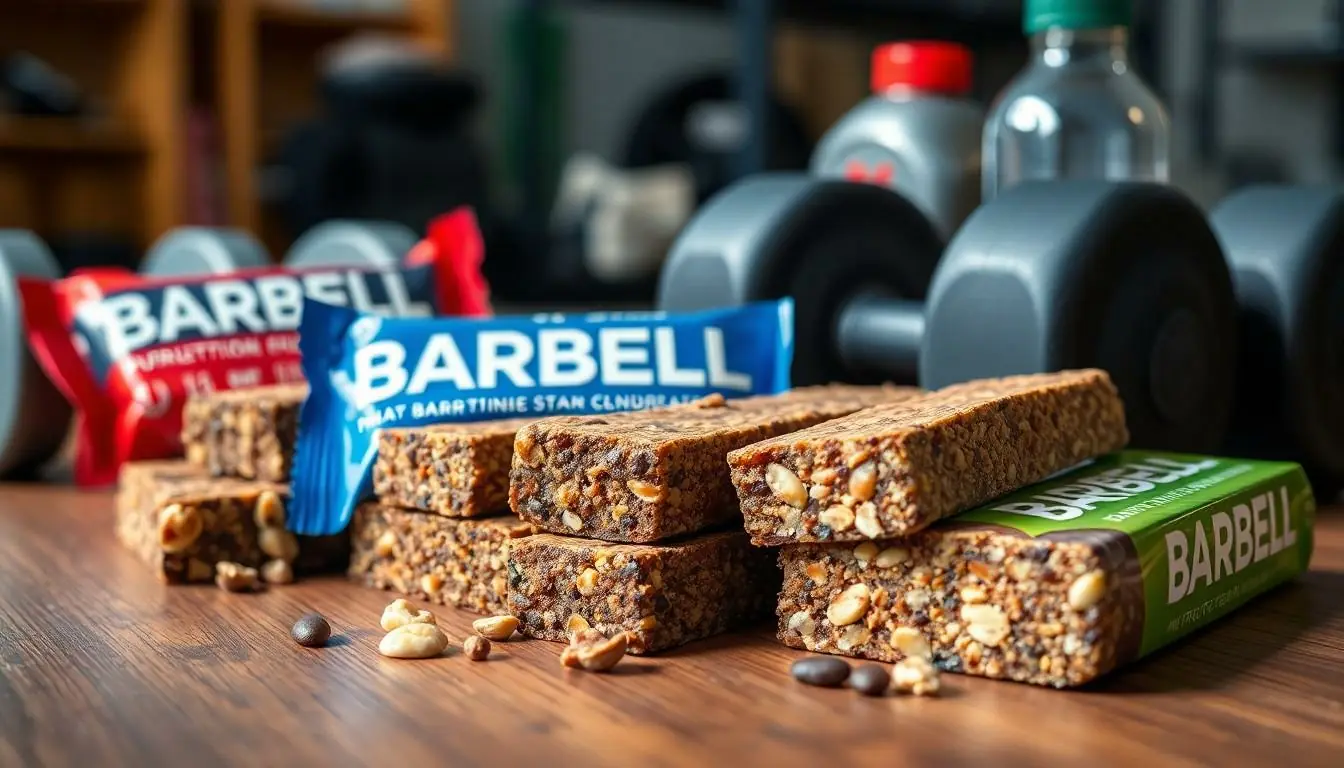In a world where snacks often come with a side of guilt, barbell protein bars are the superhero of the snack aisle. Packed with muscle-building goodness, these bars are designed to fuel workouts and satisfy cravings without the sugar crash. Imagine biting into a delicious treat that’s as nutritious as it is tasty—sounds like a dream, right?
But not all protein bars are created equal. Some are more like candy bars in disguise, while others boast impressive nutrition profiles that can help anyone crush their fitness goals. Understanding the nutrition behind barbell protein bars is key to making smart choices. So, let’s dive into the delicious world of protein-packed snacks and discover what makes these bars the perfect companion for every gym enthusiast and snack lover alike.
Table of Contents
ToggleOverview of Barbell Protein Bars
Barbell protein bars stand out in the crowded health snack market due to their balanced approach to nutrition. Each bar typically contains between 20 to 30 grams of protein, making them an excellent choice for muscle recovery and growth. Many options also offer low sugar content, often around 1 to 5 grams per bar, which helps maintain energy levels without spiking blood sugar.
Ingredients in these bars often include whey protein, casein, or plant-based proteins, catering to various dietary preferences. They usually feature whole food components like nuts, seeds, and dried fruits, enhancing nutritional value and flavor. Fiber content ranges from 5 to 15 grams, promoting digestive health and keeping individuals satisfied between meals.
Not all protein bars provide the same level of satisfaction. Many barbell protein bars use high-quality ingredients, ensuring that they deliver essential nutrients without unnecessary fillers. Snackers appreciate flavors like chocolate chip cookie dough or peanut butter brownie that mimic traditional sweets while offering health benefits.
The calorie count for these bars generally falls between 200 to 300 calories, providing a substantial yet manageable option for a post-workout snack. Consumers benefit from the convenience of a portable snack, making them ideal for on-the-go lifestyles.
Sports enthusiasts and casual snackers alike find barbell protein bars appealing as they combine nutrition and taste in every bite. By bridging the gap between indulgence and health, these bars attract those seeking effective nutritional supplementation and a delicious snack option.
Nutritional Breakdown of Barbell Protein Bars

Barbell protein bars offer a comprehensive nutritional profile, making them a popular choice among health-conscious consumers.
Protein Content
Barbell protein bars typically contain 20 to 30 grams of protein per bar, providing a significant boost for muscle recovery and growth. Protein sources like whey, casein, or plant-based proteins ensure that consumers receive quality nutrition. Individuals looking to increase protein intake find these bars particularly beneficial. Array of flavors enhances appeal while maintaining high protein content. Athletes appreciate the convenience and effectiveness of incorporating such protein-rich snacks into their diets.
Carbohydrates and Fiber
These protein bars have a carbohydrate content that generally ranges from 15 to 30 grams. Barbell bars include complex carbohydrates, which provide sustained energy throughout the day. Fiber content varies, usually between 5 and 15 grams, contributing to digestive health and increased satiety. Consuming adequate fiber helps maintain gut balance, making these bars a wholesome option. Manufacturers often use whole food ingredients like nuts and seeds to boost fiber levels naturally. Such components support a healthy digestive system while fulfilling snack cravings.
Fats and Calories
Caloric content in barbell protein bars ranges from 200 to 300 calories, making them a satisfying yet manageable snack option. Healthy fats, often derived from nuts and seeds, contribute to flavor while offering nutritional benefits. Consumers generally find that these bars contain around 5 to 10 grams of fats, striking a balance between taste and health. The low sugar level, typically about 1 to 5 grams, aids in maintaining energy without blood sugar spikes. This combination makes barbell protein bars an appealing choice for those seeking nutritious snacking options.
Ingredients Used in Barbell Protein Bars
Barbell protein bars feature a blend of high-quality ingredients designed for optimal nutrition and taste. These bars prioritize natural components while minimizing artificial additives.
Natural vs. Artificial Ingredients
Natural ingredients enhance the nutritional profile of barbell protein bars. Ingredients like whey protein isolate, casein, and plant-based protein sources provide essential amino acids. Whole food components, such as nuts and seeds, contribute healthy fats and fiber. Artificial flavors or preservatives often appear in lesser-quality bars, detracting from their health benefits. Higher-quality bars emphasize clean labels, focusing on real food sources that support overall well-being. A consumer looking for nutritious snacking options should always check the ingredient list for transparency and purity.
Allergen Considerations
Allergen considerations are essential when selecting barbell protein bars. Common allergens, including nuts, dairy, and gluten, may be present in certain varieties. Individuals with allergies must read labels carefully to ensure safe consumption. Some brands offer allergen-friendly options, catering to those sensitive to specific ingredients. Cross-contamination can occur during manufacturing, so certified allergen-free products provide additional reassurance. Knowledge about allergens helps consumers make informed choices aligned with their dietary needs.
Health Benefits of Barbell Protein Bars
Barbell protein bars provide various health benefits that support fitness and overall well-being. Their nutrient-rich profiles cater to active lifestyles and assist in maintaining health goals.
Muscle Recovery and Growth
Protein consumption plays a critical role in muscle recovery and growth. Barbell protein bars offer 20 to 30 grams of protein, which delivers the necessary amino acids for muscle repair. Whey protein, casein, and plant-based sources within these bars effectively support post-workout recovery. Individuals consuming these bars after exercise experience improved muscle synthesis and reduced soreness. Including fiber enhances overall digestive health, complementing the protein’s function. Regular intake contributes to muscle-building efforts, making these bars a strategic addition to any diet aimed at fitness.
Weight Management
Barbell protein bars can assist with weight management strategies. Their balanced macronutrient profile, including 15 to 30 grams of carbohydrates, supports sustained energy levels while keeping hunger at bay. Low sugar content, ranging from 1 to 5 grams, prevents unnecessary calorie spikes, crucial for maintaining a healthy weight. Fiber content, between 5 to 15 grams, promotes satiety and helps control cravings. Incorporating these bars as snacks or meal replacements aids individuals in making healthier food choices without feeling deprived. A convenient option, they encapsulate both nutrition and satisfaction, aligning perfectly with weight management goals.
Potential Drawbacks of Barbell Protein Bars
Barbell protein bars may pose certain drawbacks despite their nutritional benefits. Caloric content can be high, ranging from 200 to 300 calories per bar, which might not suit everyone’s dietary needs. Excessive consumption could lead to unnecessary calorie intake, especially if individuals don’t factor these bars into their daily nutrition.
Sugar levels, while relatively low at 1 to 5 grams, can still contribute to overall sugar consumption. Those monitoring their sugar intake must consider how these bars fit into their larger dietary patterns. Additionally, the carbohydrate content, which varies from 15 to 30 grams per bar, primarily consists of complex carbs. Some individuals may struggle with digesting carbs, particularly those with specific dietary restrictions.
Ingredient transparency also poses a potential concern. Although many barbell protein bars utilize high-quality ingredients, some brands may contain artificial additives or ingredients that aren’t easily recognizable. Consumers often benefit from scrutinizing ingredient lists to ensure they select products aligned with their health goals.
Allergen considerations are significant for individuals with dietary restrictions. Common allergens, such as nuts, dairy, and gluten, might be present in various flavors, necessitating careful label reading for those with sensitivities. Flavor variety, while appealing, sometimes leads to reliance on specific favorites instead of diverse nutritional options.
Lastly, portion control remains crucial. Relying solely on protein bars as meal replacements can diminish intake of essential nutrients found in whole foods. Keeping balance is key for optimal health and nutrition.
Barbell protein bars offer a nutritious and satisfying option for those looking to enhance their diet. With a solid protein content and low sugar levels they cater to both fitness enthusiasts and casual snackers. Their blend of high-quality ingredients ensures that consumers can enjoy a tasty treat while still prioritizing their health.
However it’s crucial to consider individual dietary needs and preferences. Reading labels for allergen information and ingredient transparency can help individuals make informed choices. By incorporating barbell protein bars into a balanced diet they can serve as a convenient snack or meal replacement that aligns with fitness goals and overall well-being.




